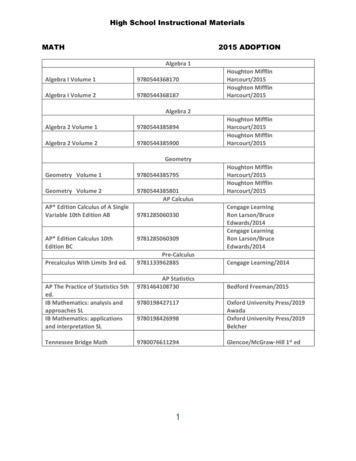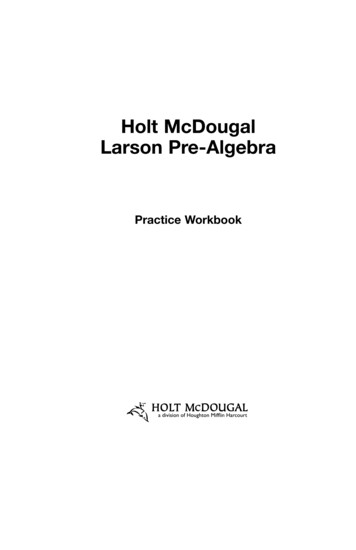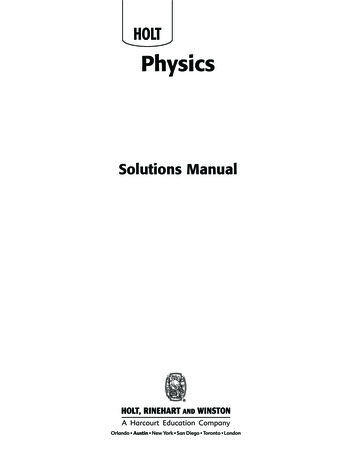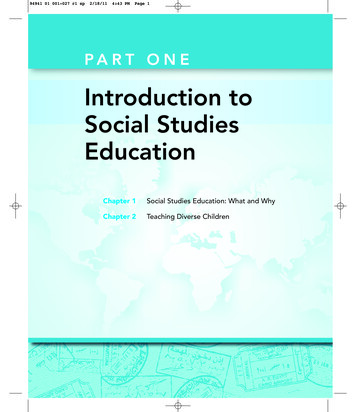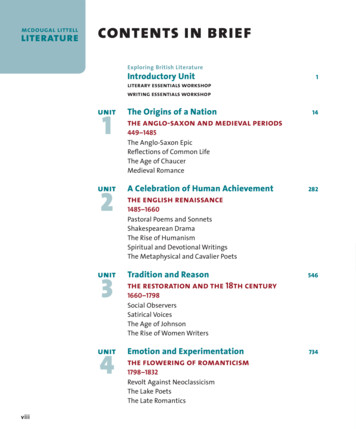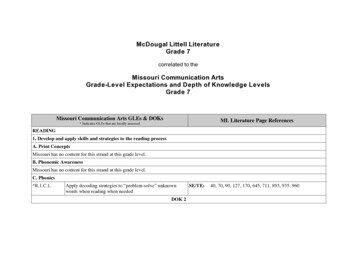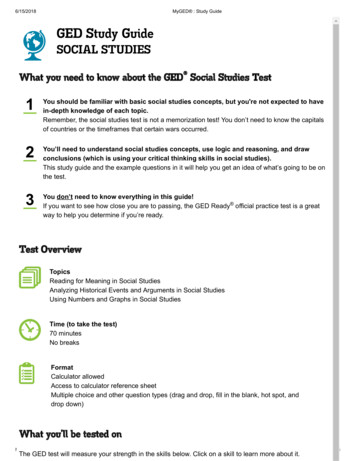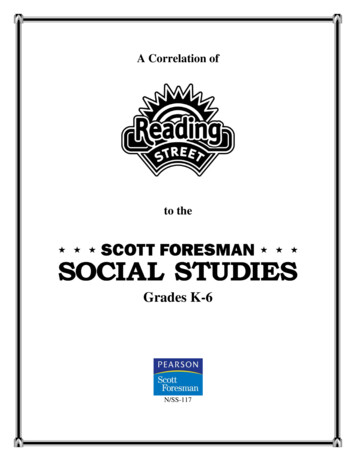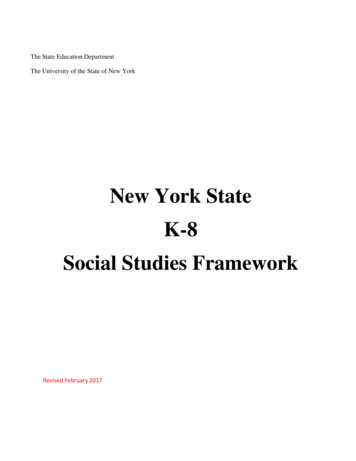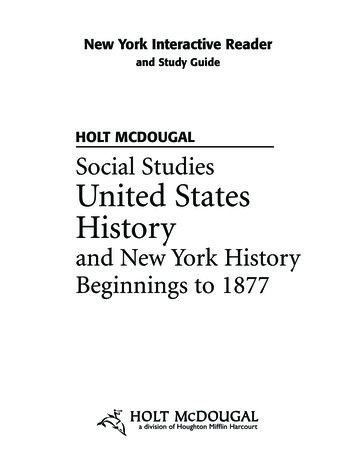
Transcription
New York Interactive Readerand Study GuideHOLT MCDOUGALSocial StudiesUnited StatesHistoryand New York HistoryBeginnings to 1877
Copyright by Holt McDougal, a division of Houghton Mifflin Harcourt PublishingCompany. All rights reserved.Warning: No part of this publication may be reproduced or transmitted in any form or byany means, electronic or mechanical, including photocopy, and recording, or by any information storage or retrieval system without the prior written permission of Holt McDougalunless such copying is expressly permitted by federal copyright law. Requests for permissionto make copies of any part of the work should be mailed to the following address: PermissionsDepartment, Holt McDougal, 10801 N. MoPac Expressway, Building 3, Austin, Texas 78759.Teachers using HOLT MCDOUGAL UNITED STATES HISTORY may photocopy completepages in sufficient quantities for classroom use only and not for resale.HOLT MCDOUGAL is a trademark of Houghton Mifflin Harcourt Publishing Company.If you have received these materials as examination copies free of charge, Holt, Rinehartand Winston retains title to the materials and they not be resold. Resale of examinationcopies is strictly prohibited and is illegal.Possession of this publication in print format does not entitle users to convert thispublication, or any portion of it, into electronic format.ISBN-13: 978-0-55-402466-0ISBN-10: 0-55-402466-71 2 3 4 5 6 7 8 9 082 12 11 10 09 08
ContentsChapter 1 The World before the Openingof the AtlanticChapter Opener with Graphic Organizer. . . 1Sec 1.1 . . . . . . . . . . . . . . . . . . . . . . . . . . . . . . . 2Sec 1.2 . . . . . . . . . . . . . . . . . . . . . . . . . . . . . . . 4Sec 1.3 . . . . . . . . . . . . . . . . . . . . . . . . . . . . . . . 6Sec 1.4 . . . . . . . . . . . . . . . . . . . . . . . . . . . . . . . 8Chapter 8 The Jefferson EraChapter Opener with Graphic Organizer. . 66Sec 8.1 . . . . . . . . . . . . . . . . . . . . . . . . . . . . . . 67Sec 8.2 . . . . . . . . . . . . . . . . . . . . . . . . . . . . . . 69Sec 8.3 . . . . . . . . . . . . . . . . . . . . . . . . . . . . . . 71Sec 8.4 . . . . . . . . . . . . . . . . . . . . . . . . . . . . . . 73Chapter 9 A New National IdentityChapter Opener with Graphic Organizer. . 75Sec 9.1 . . . . . . . . . . . . . . . . . . . . . . . . . . . . . . 76Sec 9.2 . . . . . . . . . . . . . . . . . . . . . . . . . . . . . . 78Sec 9.3 . . . . . . . . . . . . . . . . . . . . . . . . . . . . . . 80Chapter 2 New Empires in the AmericasChapter Opener with Graphic Organizer. . 10Sec 2.1 . . . . . . . . . . . . . . . . . . . . . . . . . . . . . . 11Sec 2.2 . . . . . . . . . . . . . . . . . . . . . . . . . . . . . . 13Sec 2.3 . . . . . . . . . . . . . . . . . . . . . . . . . . . . . . 15Sec 2.4 . . . . . . . . . . . . . . . . . . . . . . . . . . . . . . 17Sec 2.5 . . . . . . . . . . . . . . . . . . . . . . . . . . . . . . 19Chapter 10 The Age of JacksonChapter Opener with Graphic Organizer. . 82Sec 10.1 . . . . . . . . . . . . . . . . . . . . . . . . . . . . . 83Sec 10.2 . . . . . . . . . . . . . . . . . . . . . . . . . . . . . 85Sec 10.3 . . . . . . . . . . . . . . . . . . . . . . . . . . . . . 87Chapter 3 The English ColoniesChapter Opener with Graphic Organizer. . 21Sec 3.1 . . . . . . . . . . . . . . . . . . . . . . . . . . . . . . 22Sec 3.2 . . . . . . . . . . . . . . . . . . . . . . . . . . . . . . 24Sec 3.3 . . . . . . . . . . . . . . . . . . . . . . . . . . . . . . 26Sec 3.4 . . . . . . . . . . . . . . . . . . . . . . . . . . . . . . 28Sec 3.5 . . . . . . . . . . . . . . . . . . . . . . . . . . . . . . 30Chapter 11 Expanding WestChapter Opener with Graphic Organizer. . 89Sec 11.1 . . . . . . . . . . . . . . . . . . . . . . . . . . . . . 90Sec 11.2 . . . . . . . . . . . . . . . . . . . . . . . . . . . . . 92Sec 11.3 . . . . . . . . . . . . . . . . . . . . . . . . . . . . . 94Sec 11.4 . . . . . . . . . . . . . . . . . . . . . . . . . . . . . 96Chapter 4 The American RevolutionChapter Opener with Graphic Organizer. . 32Sec 4.1 . . . . . . . . . . . . . . . . . . . . . . . . . . . . . . 33Sec 4.2 . . . . . . . . . . . . . . . . . . . . . . . . . . . . . . 35Sec 4.3 . . . . . . . . . . . . . . . . . . . . . . . . . . . . . . 37Sec 4.4 . . . . . . . . . . . . . . . . . . . . . . . . . . . . . . 39Chapter 12 The NorthChapter Opener with Graphic Organizer. . 98Sec 12.1 . . . . . . . . . . . . . . . . . . . . . . . . . . . . . 99Sec 12.2 . . . . . . . . . . . . . . . . . . . . . . . . . . . . 101Sec 12.3 . . . . . . . . . . . . . . . . . . . . . . . . . . . . 103Sec 12.4 . . . . . . . . . . . . . . . . . . . . . . . . . . . . 105Chapter 5 Forming a GovernmentChapter Opener with Graphic Organizer. . 41Sec 5.1 . . . . . . . . . . . . . . . . . . . . . . . . . . . . . . 42Sec 5.2 . . . . . . . . . . . . . . . . . . . . . . . . . . . . . . 44Sec 5.3 . . . . . . . . . . . . . . . . . . . . . . . . . . . . . . 46Sec 5.4 . . . . . . . . . . . . . . . . . . . . . . . . . . . . . . 48Chapter 13 The SouthChapter Opener with Graphic Organizer. 107Sec 13.1 . . . . . . . . . . . . . . . . . . . . . . . . . . . . 108Sec 13.2 . . . . . . . . . . . . . . . . . . . . . . . . . . . . 110Sec 13.3 . . . . . . . . . . . . . . . . . . . . . . . . . . . . 112Chapter 6 Citizenship and the ConstitutionChapter Opener with Graphic Organizer. . 50Sec 6.1 . . . . . . . . . . . . . . . . . . . . . . . . . . . . . . 51Sec 6.2 . . . . . . . . . . . . . . . . . . . . . . . . . . . . . . 53Sec 6.3 . . . . . . . . . . . . . . . . . . . . . . . . . . . . . . 55Chapter 14 New Movements in AmericaChapter Opener with Graphic Organizer. 114Sec 14.1 . . . . . . . . . . . . . . . . . . . . . . . . . . . . 115Sec 14.2 . . . . . . . . . . . . . . . . . . . . . . . . . . . . 117Sec 14.3 . . . . . . . . . . . . . . . . . . . . . . . . . . . . 119Sec 14.4 . . . . . . . . . . . . . . . . . . . . . . . . . . . . 121Sec 14.5 . . . . . . . . . . . . . . . . . . . . . . . . . . . . 123Chapter 7 Launching the NationChapter Opener with Graphic Organizer. . 57Sec 7.1 . . . . . . . . . . . . . . . . . . . . . . . . . . . . . . 58Sec 7.2 . . . . . . . . . . . . . . . . . . . . . . . . . . . . . . 60Sec 7.3 . . . . . . . . . . . . . . . . . . . . . . . . . . . . . . 62Sec 7.4 . . . . . . . . . . . . . . . . . . . . . . . . . . . . . . 64Copyright Holt McDougal. All rights reserved.iiiInteractive Reader and Study Guide
ContentsChapter 15 A Divided NationChapter Opener with Graphic Organizer. 125Sec 15.1 . . . . . . . . . . . . . . . . . . . . . . . . . . . . 126Sec 15.2 . . . . . . . . . . . . . . . . . . . . . . . . . . . . 128Sec 15.3 . . . . . . . . . . . . . . . . . . . . . . . . . . . . 130Sec 15.4 . . . . . . . . . . . . . . . . . . . . . . . . . . . . 132Sec 16.2Sec 16.3Sec 16.4Sec 16.5. . . . . . . . . . . . . . . . . . . . . . . . . . . . 137. . . . . . . . . . . . . . . . . . . . . . . . . . . . 139. . . . . . . . . . . . . . . . . . . . . . . . . . . . 141. . . . . . . . . . . . . . . . . . . . . . . . . . . . 143Chapter 17 ReconstructionChapter Opener with Graphic Organizer. 145Sec 17.1 . . . . . . . . . . . . . . . . . . . . . . . . . . . . 146Sec 17.2 . . . . . . . . . . . . . . . . . . . . . . . . . . . . 148Sec 17.3 . . . . . . . . . . . . . . . . . . . . . . . . . . . . 150Chapter 16 The Civil WarChapter Opener with Graphic Organizer. 134Sec 16.1 . . . . . . . . . . . . . . . . . . . . . . . . . . . . 135Copyright Holt McDougal. All rights reserved.ivInteractive Reader and Study Guide
NameClassDateThe World before the Opening of the AtlanticCHAPTER SUMMARYThe EarliestAmericansNative AmericanCulturesTrading Kingdoms of Europe beforeWest AfricaTransatlantic TravelThe firstAmericansmigrated tothe Americasby crossing theduring the lastIce Age.Several NativeAmerican culturesexisted in NorthAmerica before theEuropeans came.By controllingtrade, threegreat kingdomsdeveloped in WestAfrica. These werethe kingdoms ofGhana, Mali, and.The Greeksdeveloped asystem ofgovernment called,in which peoplerule themselves.Four earlyAmericancivilizationswere the Olmec,Maya, Aztec, and.The cultures ofNative Americanpeople varieddepending on.A key part ofthe West Africaneconomy was thetrade.After the BlackDeath, the feudalsystem weakenedand a middle classdeveloped.Native Americancultures sharedbeliefs aboutreligion and.The Renaissancewas a rebirth ofarts and learning.COMPREHENSION AND CRITICAL THINKINGAs you read the section summaries, fill in the blanks in the graphicorganizer above and answer the questions below.1. Explain What are cultural areas? How did they shape the ways different NativeAmerican peoples developed?2. Compare and Contrast How were the societies that existed in the Old and NewWorlds before transatlantic travel similar? How were they different?Copyright Holt McDougal. All rights reserved.1Interactive Reader and Study Guide
NameClassDateThe World before the Opening of the AtlanticSection 1MAIN IDEAS1. Climate changes allowed Paleo-Indians to begin the first migration to theAmericas.2. Early societies existed in Mesoamerica and South America.Key Terms and Peoplea strip of land between Asia and present-day Alaska that wasexposed by the lower sea levels of the Ice AgePaleo-Indians people believed to have crossed the Bering Land Bridgemigration movement of people or animals from one region to anotherhunter-gatherers people who obtain food by hunting animals and gathering plantsenvironments climates and landscapes that surround living thingsculture a group’s set of common values and traditionsBering Land BridgeAcademic Vocabularydevelopthe process of growing or improvingSection SummaryFIRST MIGRATION TO THE AMERICASMany scientists believe that the first peoplearrived in North America during the last Ice Age.At that time the environment changed, and largeamounts of water froze, forming glaciers. Waterlevels in the oceans dropped to more than 300 feetlower than they are today. A strip of land called theBering Land Bridge was exposed between Asiaand Alaska.No one knows exactly when or how people crossedinto North America, but there is evidence that peoplecalled Paleo-Indians crossed the bridge to Alaskabetween 38,000 and 10,000 BC. The migration tookplace over a long time. The descendents of the migrantswent as far as the southern tip of South America. Thesepeople were hunter-gatherers, people who huntedanimals and gathered wild plants for food. The environments they settled in created Native American societies.How did the formation ofglaciers during the Ice Age allowfor migration to North America?Do scientists know exactly whenthe Paleo-Indians crossed intoNorth America?Copyright Holt McDougal. All rights reserved.2Interactive Reader and Study Guide
NameClassDateSection 1, continuedEARLY MESOAMERICAN AND SOUTH AMERICAN SOCIETIESSome of the earliest American cultures arose inMesoamerica, a region that includes the southernpart of what is now Mexico and northern CentralUnderline the sentence thatAmerica. The Olmec developed the earliest knowntells when the first civilizationdeveloped in Mesoamerica.civilization in Mesoamerica around 1200 BC. TheOlmec are known for their stone buildings andsculptures. By 400 BC, when their civilizationended, trade had spread Olmec culture.The Maya civilization followed the Olmec. TheMaya built large stone temples, pyramids, andcanals that controlled the flow of water throughtheir cities. The Maya civilization began to collapsein the 900s, but historians are still not sure why.The Aztec were fierce warriors who migratedto south and central Mexico in the mid-1100s.They conquered many towns, built a large empire,What was the greatest city in theAmericas during the height of theand controlled a huge trading network. The AztecAztec culture?capital, Tenochtitlán (tay-nawch-teet-LAHN),founded in 1325 AD, became the greatest city in theAmericas and one of the world’s largest cities. TheAztec became rich on trade and tributes paid byconquered people.What evidence do we have thatcultures existed in MesoamericaThe Inca began as a small tribe in the Andesbefore the Aztecs?Mountains. In the mid-1400s, the Inca beganexpanding their empire until it included much ofthe western coast of South America and had morethan 12 million people. The Inca people had astrong central government and a network of roadsand bridges that connected all parts of the territory.CHALLENGE ACTIVITYCritical Thinking: Evaluate Imagine that you lived in Mesoamerica orSouth America before the arrival of Europeans. Write a short paragraphdescribing which of the four civilizations discussed above you wouldhave preferred to live in. Be sure to support your answer.Copyright Holt McDougal. All rights reserved.3Interactive Reader and Study Guide
NameClassDateThe World before the Opening of the AtlanticSection 2MAIN IDEAS1. Several early societies developed in North America long before Europeansexplored the continent.2. Geographic areas influenced Native American cultures.3. Native American cultures shared beliefs about religion and land ownership.Key Terms and Peopleaboveground houses made of a heavy clay called adobekivas underground ceremonial chambers at the center of each Anasazi communitytotems ancestor or animal spirits of the Native Americans of the Pacific Northwestteepees cone-shaped shelters made of animal hides by the nomadic plains peoplematrilineal a society that traces ancestry through mothersIroquois League an alliance of Native Americans in northeastern North AmericapueblosSection SummaryEARLY SOCIETIESThe earliest people in North America were huntergatherers. By 1500 BC people in the southwesternpart of North America had farm cultures and grewmaize. The Anasazi used irrigation to increase foodproduction in the dry climate. They lived in pithouses dug into the ground and later began to buildpueblos. The Anasazi often built complex houses oncliff walls to defend against attacks. They also builtkivas, sacred areas at the center of the community.The Anasazi began abandoning their villages afterliving in them for hundreds of years. Drought, disease, or raids by other tribes may have caused thismove.After 1000 BC several farming societies developedin the eastern part of North America. They builtlarge burial mounds to honor their dead. More than10,000 mounds have been found in the Ohio Rivervalley alone. The largest city of the mound buildershad about 30,000 people.How would building on cliff wallsprovide protection for the Anasazi?Why would drought be one of thepossible reasons that the Anasazimoved from their homes?Copyright Holt McDougal. All rights reserved.4Interactive Reader and Study Guide
NameClassDateSection 2, continuedNATIVE AMERICAN CULTURE AREASThe culture of Native American people varieddepending on geography. In the far north, inpresent-day Alaska and Canada, Native Americanssurvived primarily by hunting and fishing,living in small groups. Farther south, along thePacific Northwest, larger groups thrived on theabundant wildlife. They carved tall poleswith totems—symbols of animal or ancestorspirits—which had religious and cultural meaning.Farther south along the Pacific and the SierraNevada Mountains, people fished, hunted, gatheredplants, and lived in small groups of families. In thedrier areas of the southwest, Pueblo groups had todevelop agriculture to adapt to the climate. Theylived in towns of up to 1000 people. Others, suchas the Apache and Navajo, formed nomadic groupsthat survived by hunting, foraging, or raiding othervillages.Most of the Native Americans of the Great Plainswere nomadic hunters. They survived on the abundant wildlife of the grasslands, living in teepeesmade of animal hides. Some Plains groups werefarmers, including the Pawnee, who had a matrilineal society. In the east, many Native Americanshad small villages and lived by farming, hunting,and fishing. The Iroquois League was an alliance ofmany groups that defended one another.What was the significance of thecharacters carved on totem poles?Describe the food and shelter ofthe Native Americans of the GreatPlains.SHARED BELIEFSAlthough they had many different cultures, NativeAmericans shared certain beliefs. Their religionswere linked to nature, and they believed that theland was for the use of everyone.CHALLENGE ACTIVITYCritical Thinking: Comparing Pick two Native American groups fromtwo different culture areas. Make a chart comparing these two societies.Copyright Holt McDougal. All rights reserved.5Interactive Reader and Study Guide
NameClassDateThe World before the Opening of the AtlanticSection 3MAIN IDEAS1. West Africa developed three great kingdoms that grew wealthy through theircontrol of trade.2. Slaves became a valuable trade item in West Africa.Key Terms and PeopleNorth African people who established trade routes through West AfricaMansa Musa a Muslim king who ruled the Mali Empire at the height of its power andwho spread Islamic influence through a large part of West Africahajj in Islam, a pilgrimage to the holy city of Meccamosques Islamic places of worshipAskia the Great the Muslim ruler who led Songhai to the height of its powerBerbersSection SummaryWEST AFRICA’S GREAT KINGDOMSWest African trade routes were originally controlledby the Berbers, a people of North Africa. Later,three great kingdoms developed in West Africaby winning control of these trade routes.The first, Ghana, formed when farmers bandedtogether to protect themselves from herders. Theybuilt armies whose superior iron weapons letthem take control of the trade in salt and gold.Ghana raised money by forcing traders who passedthrough its lands to pay taxes. The trade routesbrought Ghana in contact with different culturesand beliefs. In the 1060s a Muslim group attackedGhana, forcing its leaders to convert to Islam.Although Ghana was weakened and eventually fell,the influence of Islam remained strong.Like Ghana, Mali was located along the upperNiger River. The fertile soil and the control of tradeon the river allowed Mali to become rich and powerful. Its most famous ruler was a Muslim king,Mansa Musa. Under his leadership Mali grew inwealth and power. Traders came to Timbuktu, anWhat was the main source of thewealth and power of all the WestAfrican empires?What river flowed through bothGhana and Mali?Copyright Holt McDougal. All rights reserved.6Interactive Reader and Study Guide
NameClassDateSection 3, continuedimportant city, to trade for salt, gold, metals, shells,and other goods.Because he was a devout Muslim, Mansa Musaleft Mali on a hajj, or a pilgrimage to Mecca. Hisinfluence helped bring Islam to a large part of WestAfrica. In the 1300s Mansa Musa conquered a kingdom called Songhai, whose people also lived alongthe Niger River. As the Mali empire weakened in the1400s, Songhai regained independence.One of the greatest Songhai rulers wasMuhammad Ture. He chose a military title, askia,and became known as Askia the Great. LikeMansa Musa, Askia was a devout Muslim who supported education and learning. His cities had greatmosques, schools, and libraries. He built a professional army and organized Songhai with governorswho were loyal to him. Songhai declined soon afterAskia the Great lost power.WEST AFRICAN SLAVE TRADESlavery had existed in Africa and in many parts ofthe world for centuries. Starting in the 600s Arabsand then Europeans became slave traders. Criminalsand people captured during battle could be soldinto slavery as well as relatives of people who owedmoney.The market for West African slaves increased asMuslim traders took black Africans to sell in NorthAfrica. West Africa was also the home of manyslaves taken to the Americas. The slave trade becamea key part of the West African economy, contributing to the power of the great empires.What did Mansa Musa and Askiathe Great have in common?Underline the sentence thatexplains how it was determinedwho would become a slave inWest Africa.CHALLENGE ACTIVITYCritical Thinking: Elaborate Imagine that you live in one of the king-doms discussed in this section. Write a brief description of what anaverage day might be like.Copyright Holt McDougal. All rights reserved.7Interactive Reader and Study Guide
NameClassDateThe World before the Opening of the AtlanticSection 4MAIN IDEAS1. The Greeks and Romans established new forms of government.2. During the Middle Ages, society eventually changed from a feudal system tothe development of a middle class of artisans and merchants.3. The Renaissance created a rebirth of arts and learning.Key Terms and PeopleGreek teacher who wanted people to question their own beliefsPlato Greek philosopher who wrote Republic, about an ideal societyAristotle Greek philosopher who thought people should live based on reasonreason clear or ordered thinkingdemocracy a form of government in which people rule themselvesknights feudal warriors who fought on horsebackBlack Death a disease that spread across Europe, killing 25 million peopleMichelangelo Italian Renaissance artist known for paintings and sculptureLeonardo da Vinci Italian artist, inventor, engineer, and mapmaker of the RenaissanceJohannes Gutenberg German inventor of the moveable type printing pressjoint-stock companies businesses in which a group of people invest togetherSocratesAcademic Vocabularyclassicalreferring to the cultures of ancient Greece and RomeSection SummaryGREEK AND ROMAN GOVERNMENTAncient Greeks valued human reason and believedin the power of the human mind to think, explain,and understand life. Three of the greatest Greekthinkers were Socrates, Plato, and Aristotle, whowere all philosophers and teachers. Aristotle taughtthat people should live lives based on reason, orclear and ordered thinking.One of the most lasting contributions of theGreeks is their political system. Established duringthe Classical Period, democracy is the system inwhich people rule themselves. Rome later formed aWho were three of the greatestGreek thinkers?Underline the sentence thatdescribes the Greek contributionof a political system.Copyright Holt McDougal. All rights reserved.8Interactive Reader and Study Guide
NameClassDateSection 4, continuedtype of democracy called a republic, in which people elect representatives to rule them. These politicalideas still influence world governments, includingthat of the United States.MIDDLE AGESAfter the fall of the Roman empire, Europe wasdivided into many small kingdoms. A system calledfeudalism was established in which nobles gaveknights land in exchange for protection.In the 1000s important changes began to occurin Europe. The Crusades brought trade with placesoutside Europe, introducing new products and ideas.Trade also brought a disease known as the BlackDeath that killed much of the population of Europeand caused a shortage of workers. These changesresulted in the development of a middle-class madeup of artisans and merchants. Cities became important as commercial centers for trade.RENAISSANCEThe key feature of the Renaissance was a love of artand education. The search for knowledge spreadto all fields. During the Renaissance the focusshifted from religion to people. Two of the greatRenaissance artists, Michelangelo and Leonardo daVinci, are famous for their paintings, sculpture, andarchitecture, which reflected the value of the humanbeing. The printing press developed by JohannesGutenberg helped spread new ideas in science,math, and literature.Increased trade caused a commercial revolution. Italian cities became important trading centers. As commerce grew, so did the need for banks.Merchants created joint-stock companies in whichgroups of people invested together.How did the Black Death causechanges in commerce?Underline the key feature of theRenaissance.What helped spread new ideasduring the Renaissance?CHALLENGE ACTIVITYCritical Thinking: Evaluate Make a chart showing some of democracy’sadvantages.Copyright Holt McDougal. All rights reserved.9Interactive Reader and Study Guide
NameClassDateNew Empires in the AmericasCHAPTER SUMMARYCAUSEEFFECTEconomic growth in EuropeSearch for new trade routes toandSearch for trade routesLed to new exchanges between, Africa, and the AmericasNeed for trading partners byEuropean powers, , ,, and establishedcolonies in the Americas.Death of many Native Americanpeople by diseaseShortage of laborers in the colonies ledto the development of .COMPREHENSION AND CRITICAL THINKINGAs you read the section summaries, fill in the blanks in the graphicorganizer above and answer the questions below.1. Identify Cause and Effect To which continents did Europeans seek new traderoutes in the 1400s? What continent unknown to them did they find?2. Identify Cause and Effect How did the Spanish conquests help Spain grow rich?3. Make Inferences How do you think the military strength of European countriescenturies ago affects cultures in the Americas today?4. Identify Cause and Effect How did the colonists find forced laborers to replacethe Native Americans whose populations were devastated by disease?Copyright Holt McDougal. All rights reserved.10Interactive Reader and Study Guide
NameClassDateNew Empires in the AmericasSection 1MAIN IDEAS1. Vikings were skilled sailors, and they were the first Europeans to reach NorthAmerica.2. Prince Henry the Navigator established a school for sailors and provided financial support that enabled the Portuguese to start exploring the oceans.3. Portuguese sailors sailed around Africa and found a sea route to Asia.Key Terms and PeopleViking who landed in present-day Canada in AD1000Henry the Navigator Portuguese prince who established a school of navigation andpaid for expeditionsastrolabe a device used to determine location based on the position of the starscaravels Portuguese ships that used triangular sails to sail against the windLeif ErikssonAcademic Vocabularyeffectthe result of an action or decisionSection SummarySKILLED VIKING SAILORSThe Vikings were the first Europeans to make contact with North America. They were skilled sailorswho developed a new style of ship that was morestable on rough seas.In the year 1000, Leif Eriksson, the son of Erikthe Red, set off for Greenland. Strong winds blewhis ship off course, and he landed on the NorthAmerican coast. The Vikings settled in a coastal areathat Eriksson called Vinland, but they left after a fewyears. Europeans did not return to the continent forcenturies.Who were the first Europeans tosettle in North America?PRINCE HENRY THE NAVIGATORIn the early 1400s Portugal became a leader inworld exploration. Although he never set out on avoyage himself, Prince Henry the Navigator helpedPortugal’s explorers succeed. He built anWhat European country led worldexploration in the early 1400s?Copyright Holt McDougal. All rights reserved.11Interactive Reader and Study Guide
NameClassDateSection 1, continuedobservatory and a school of navigation to teach better methods of sailing. Europeans had several reasons to explore the world. They wanted spices fromAsia, and they wanted to learn more about Asia andits culture. They also wanted to convert Asians tothe Christian faith.European sailors were able to travel in open seaswithout landmarks to guide them because of newtechnology. The astrolabe was used to chart a ship’slocation based on the position of the stars. Thecaravel was a new kind of ship that was smaller,lighter, and easier to steer. Caravels used triangularsails that allowed ships to sail against the wind andrudders that improved steering.A SEA ROUTE TO ASIAIn the 1400s Portuguese sailors traveled south alongthe coast of Africa, setting up trading posts alongthe way. In 1497 a Portuguese expedition led byVasco da Gama sailed around the southern tip ofAfrica and reached India. These successful voyageshad a number of effects, both positive and negative.Portugal’s wealth and power increased. However,these travels eventually led to the spread of the slavetrade. Other European nations soon began lookingfor their own sea routes to Asia.Why did Europeans want toexplore the world?What was the first sea route fromEurope to Asia?CHALLENGE ACTIVITYCritical Thinking: Making Inferences The Portuguese had laws thatincluded severe penalties for letting sailors from other countries see themaps the Portuguese created from their expeditions. Write a paragraphexplaining why they wanted to keep these maps secret.Copyright Holt McDougal. All rights reserved.12Interactive Reader and Study Guide
NameClassDateNew Empires in the AmericasSection 2MAIN IDEAS1. Christopher Columbus sailed across the Atlantic Ocean and reached a continent that was previously unknown to him.2. After Columbus’s voyages, other explorers sailed to the Americas.Key Terms and Peoplea sailor from Genoa, ItalyLine of Demarcation an imaginary boundary in the Atlantic dividing Spanish andPortuguese territoriesTreaty of Tordesillas agreement between Spain and Portugal moving the Line ofDemarcationFerdinand Magellan Portuguese navigator whose expedition circumnavigated theglobecircumnavigate to go all the way around the globeColumbian Exchange the transfer of plants and animals between the Americas andAsia, Africa, and EuropeChristopher ColumbusSection SummaryCOLUMBUS SAILS ACROSS THE ATLANTICChristopher Columbus, a sailor from Genoa, Italy,believed that he could reach Asia by sailing westacross the Atlantic Ocean. He asked King Ferdinandand Queen Isabella of Spain to pay for an expedition. In return, he promised great riches, new territory, and Catholic converts.Sailing with three ships, Columbus reached anisland in the Bahamas in 1492. Columbus thoughthe had found a new route to Asia. In reality he hadreached another continent that was unknown tohim. Columbus made three more journeys to theAmericas during his lifetime. When he died in 1506he still believed that he had reached Asia.The voyages of Columbus changed the wayEuropeans saw the world and also
American civilizations were the Olmec, Maya, Aztec, and _. The cultures of Native American people varied depending on _. A key part of the West African economy was the _ trade. After the Black Death, the feudal system weakened and a middle class developed. Native American cultures
